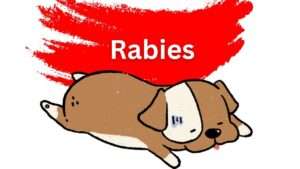In the world of our beloved furry companions, keeping them safe and healthy is paramount. Canine parainfluenza, a contagious respiratory disease, poses a threat to our canine friends.
Understanding its nuances, from symptoms to prevention, is crucial for every dog owner. Let’s delve into this ailment, exploring its causes, symptoms, treatment, and preventive measures.
Contents Overview
What is Canine Parainfluenza
Canine parainfluenza virus (CPIV) belongs to the family Paramyxoviridae and is a common culprit behind infectious respiratory disease in dogs. This virus primarily affects the respiratory system, leading to symptoms ranging from mild coughing to severe respiratory distress. While often less severe than other respiratory infections, such as canine influenza, CPIV can still pose risks, especially to young puppies and dogs with weakened immune systems.
Symptoms and Signs
. Coughing:
Persistent dry cough is one of the hallmark symptoms of canine parainfluenza.
The cough may worsen with exercise or excitement and can sometimes be accompanied by gagging or retching.
Nasal Discharge:
Dogs with parainfluenza may exhibit clear to yellowish nasal discharge.
This discharge may vary in consistency, ranging from watery to thick mucus.
Sneezing:
Sneezing can be another common symptom of parainfluenza in dogs.
It may occur intermittently and can accompany nasal discharge.
Fever:
Elevated body temperature, typically above 102.5°F (39.2°C), can indicate an active infection.
Fever may contribute to lethargy and loss of appetite in affected dogs.
Lethargy:
Dogs with parainfluenza often exhibit reduced energy levels and increased sleepiness.
They may be less interested in activities they usually enjoy.
Loss of Appetite:
A decrease in appetite is a common sign of illness in dogs, including parainfluenza.
Dogs may show reluctance to eat or drink, leading to dehydration if left untreated.
Eye and Nose Redness:
In some cases, dogs with parainfluenza may have redness and inflammation around the eyes and nose.
This can be due to irritation from coughing, sneezing, and nasal discharge.
Difficulty Breathing:
Severe cases of parainfluenza may lead to respiratory distress, characterized by labored breathing and wheezing.
This is a medical emergency and requires immediate veterinary attention.
Secondary Infections:
Parainfluenza weakens the immune system, making affected dogs more susceptible to secondary bacterial infections.
Symptoms of secondary infections may include green or yellow nasal discharge, fever, and worsening respiratory signs.
Transmission:
Canine parainfluenza is highly contagious and spreads through respiratory droplets from infected dogs.
It can also be transmitted through contaminated objects such as food and water bowls, toys, and bedding.
Incubation Period:
After exposure to the virus, dogs may show symptoms within 3 to 10 days.
However, some infected dogs may remain asymptomatic carriers, shedding the virus without showing signs of illness.
Transmission and Spread
Modes of Transmission:
CPIV spreads through various routes, facilitated by close contact between infected and susceptible dogs. Understanding these modes of transmission is essential for preventing the spread of the virus:
- Direct Contact:
- Close interaction between infected and healthy dogs, such as sniffing, licking, or sharing food and water bowls.
- Direct contact with respiratory secretions like saliva, nasal discharge, or aerosols expelled during coughing and sneezing.
- Indirect Contact:
- Contaminated objects and surfaces, including toys, bedding, grooming equipment, and clothing, can harbor the virus for hours to days.
- Dogs may contract the virus by coming into contact with these contaminated items and subsequently touching their noses or mouths.
- Airborne Transmission:
- Respiratory droplets expelled by infected dogs can remain suspended in the air for a short period, especially in enclosed spaces like kennels, shelters, and veterinary clinics.
- Dogs in close proximity to infected individuals are at risk of inhaling these infectious particles, leading to transmission.
Factors Affecting Spread:
Several factors influence the transmission dynamics of CPIV within dog populations:
- Density:
- High-density environments, such as kennels, dog parks, and shelters, increase the likelihood of transmission due to closer proximity between animals.
- Stress and Immune Status:
- Stress weakens the immune system, making dogs more susceptible to infections like CPIV.
- Puppies, elderly dogs, and those with compromised immune systems are particularly vulnerable to severe illness and transmission.
- Travel and Socialization:
- Dogs that frequently travel, participate in dog shows, or visit communal spaces are at higher risk of exposure to CPIV.
Diagnosis and Treatment
Diagnosis: Shedding Light on the Disease
Prompt and accurate diagnosis is essential for initiating appropriate treatment and preventing the spread of canine parainfluenza. Veterinary professionals employ various methods to confirm the presence of the virus:
- Physical Examination: Your veterinarian will assess your dog’s symptoms and perform a thorough physical examination.
- Diagnostic Tests: Tests such as polymerase chain reaction (PCR) and serological assays can detect the presence of the parainfluenza virus in respiratory secretions or blood samples.
- Imaging Studies: Chest X-rays may be conducted to evaluate the extent of lung involvement and assess for secondary complications.
Treatment Approaches: Combating the Virus
Treating canine parainfluenza involves alleviating symptoms, preventing secondary infections, and supporting the immune system’s fight against the virus. Here are the primary treatment modalities:
- Medication: Veterinarians may prescribe cough suppressants to alleviate coughing and antibiotics to prevent secondary bacterial infections.
- Fluid Therapy: Intravenous fluids may be administered to prevent dehydration and maintain electrolyte balance, especially in cases of severe respiratory distress.
- Isolation: Infected dogs should be isolated from healthy individuals to prevent the spread of the virus.
- Supportive Care: Providing a warm, comfortable environment and encouraging rest can aid in recovery.
Preventive Measures
- Vaccination:
- Ensure your dog receives regular vaccinations, including the parainfluenza vaccine, as part of their core vaccination protocol.
- Puppies should start their vaccination series at around 6-8 weeks of age, with booster shots administered as per the veterinarian’s recommendation.
- Adult dogs should receive booster shots annually or as advised by the veterinarian.
- Avoid Exposure:
- Limit your dog’s exposure to unfamiliar dogs, especially in crowded or high-risk areas such as dog parks, kennels, or grooming facilities.
- If your dog shows signs of illness, keep them away from other dogs to prevent potential transmission.
- Hygiene Practices:
- Practice good hygiene by regularly cleaning and disinfecting your dog’s living area, toys, food and water bowls, and grooming tools.
- Wash your hands thoroughly with soap and water after handling other dogs, especially if they exhibit respiratory symptoms.
- Healthy Lifestyle:
- Maintain your dog’s overall health through a balanced diet, regular exercise, and routine veterinary check-ups.
- Address any underlying health conditions promptly to strengthen their immune system and reduce susceptibility to infections.
- Quarantine Protocol:
- If you bring home a new dog or suspect exposure to parainfluenza, consider implementing a quarantine period to monitor for symptoms before introducing them to other pets.
- Awareness and Education:
- Stay informed about the signs and symptoms of canine parainfluenza to recognize early warning signs in your dog.
- Educate yourself and fellow dog owners about preventive measures and responsible pet ownership to collectively reduce the spread of infectious diseases.
Bottom Line
Canine parainfluenza is a contagious respiratory disease that can affect dogs of all ages. While usually less severe than other respiratory infections, it can still cause discomfort and illness in infected dogs. Recognizing the symptoms, understanding transmission routes, and implementing preventive measures are crucial steps in safeguarding our furry companions. With proper care, vaccination, and hygiene practices, we can minimize the risk of canine parainfluenza and ensure the well-being of our canine friends. Stay informed, stay vigilant, and let’s keep our dogs healthy and happy.




































+ There are no comments
Add yours